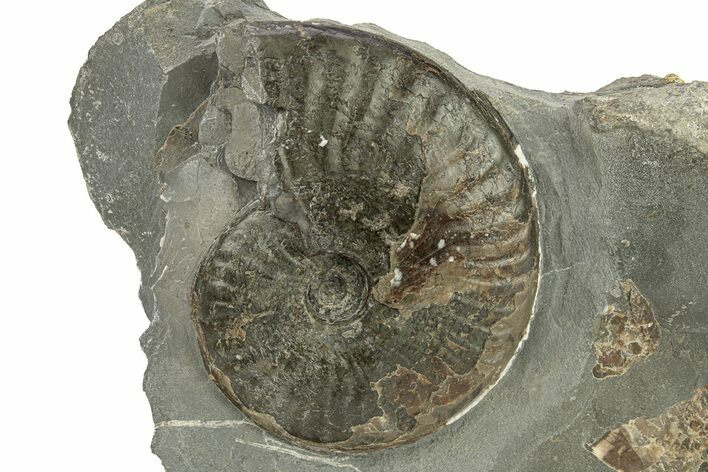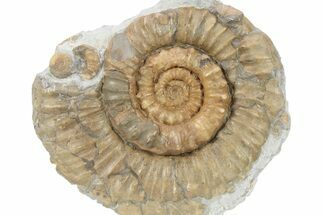This Specimen has been sold.
2.7" Jurassic Ammonite (Pseudolioceras) Fossil - England
This is a British ammonite of the species Pseudolioceras lythense. These well preserved ammonites are Jurassic in age and are found in hard concretions that must be split open to reveal the fossil. The hard rock then has to be removed mechanically to further expose the fossil.
One edge of the nodule has been cut flat for presentation.
One edge of the nodule has been cut flat for presentation.
About Ammonites
Ammonites were ancient marine cephalopods, similar to today's squids and octopuses, but with a defining feature: their distinctive, tightly coiled spiral shells. These shells, resembling those of modern nautiluses, served as both a protective home and a buoyancy aid, allowing ammonites to navigate the prehistoric seas with ease. First emerging around 240 million years ago in the Triassic Period, ammonites thrived for over 175 million years, adapting through numerous forms and sizes. As predatory creatures, they likely fed on smaller marine organisms, using their tentacles to capture prey. However, their long reign came to an end 65 million years ago at the close of the Cretaceous, coinciding with the mass extinction event that also eliminated the dinosaurs.
Ammonites were ancient marine cephalopods, similar to today's squids and octopuses, but with a defining feature: their distinctive, tightly coiled spiral shells. These shells, resembling those of modern nautiluses, served as both a protective home and a buoyancy aid, allowing ammonites to navigate the prehistoric seas with ease. First emerging around 240 million years ago in the Triassic Period, ammonites thrived for over 175 million years, adapting through numerous forms and sizes. As predatory creatures, they likely fed on smaller marine organisms, using their tentacles to capture prey. However, their long reign came to an end 65 million years ago at the close of the Cretaceous, coinciding with the mass extinction event that also eliminated the dinosaurs.
SPECIES
Pseudolioceras lythense
LOCATION
Nr. Whitby, North Yorkshire, England
FORMATION
Upper Lias - Commune Zone
SIZE
Ammonite: 2.7" wide, Entire Specimen: 5 x 3.4"
CATEGORY
SUB CATEGORY
ITEM
#279551
We guarantee the authenticity of all of our specimens.
 Reviews
Reviews












